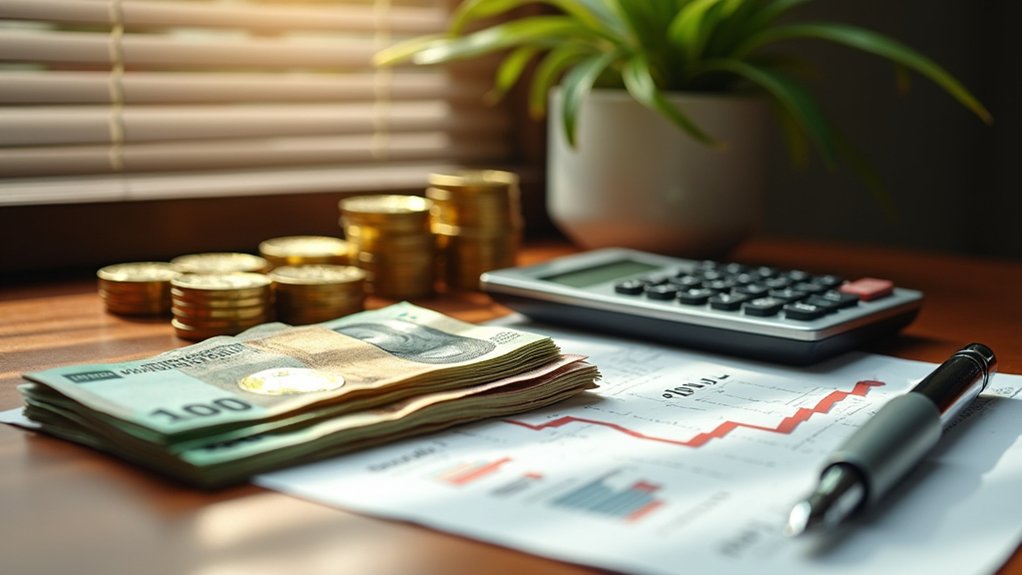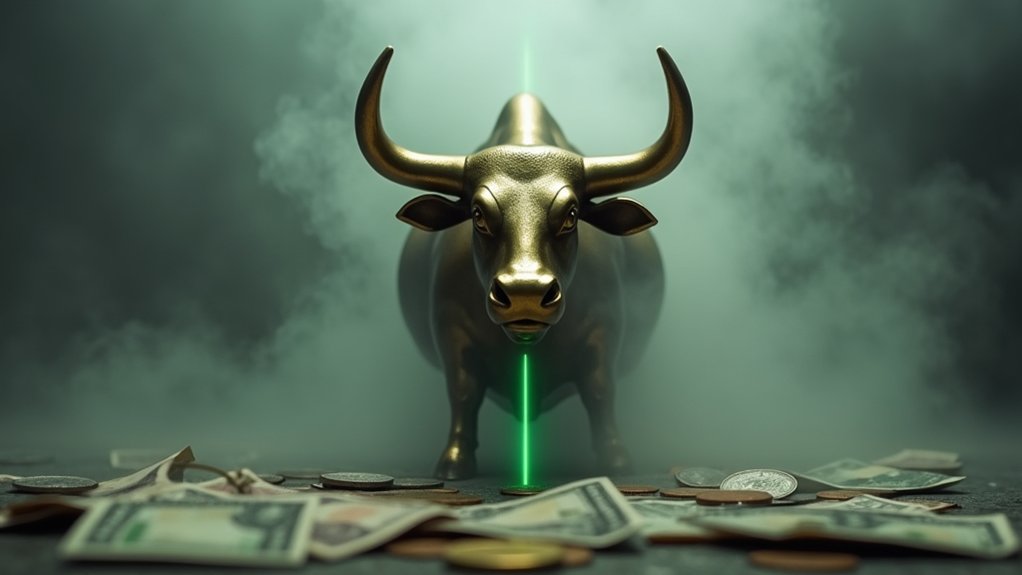Traders avoid overleveraging by capping position size at 1–2% of account equity per trade, using low leverage ratios instead of chasing the 500:1 nonsense unregulated brokers advertise, and setting hard stop-losses before entering positions. Professional norms demand disciplined risk-reward ratios of at least 1:2, documented trades in a journal, and backtesting strategies under realistic leverage scenarios. The math is brutal: a 50% loss needs a 100% gain just to break even, and a 90% wipeout requires 900% recovery—numbers that explain why over 70% of retail accounts implode. What follows breaks down the mechanics.

Because brokers across Africa dangle leverage ratios like candy—sometimes 500:1, even 1000:1 in less regulated markets—traders from Lagos to Nairobi routinely blow up their accounts within weeks. The pattern repeats itself with crushing regularity. A trader in Accra opens an account, sees the option to control $100,000 with just $200, and thinks he's discovered a cheat code. He hasn't. He's discovered a landmine.
The math is brutal and unforgiving. A 50% loss demands a 100% gain just to break even. A 90% wipeout? That requires a 900% return. Most accounts never recover. Over 70% of retail forex traders loses money, and excessive leverage sits at the center of that carnage like a smoking gun. When a trader in Kampala or Johannesburg risks 10% or more per trade, they're not being aggressive—they're being reckless. Professional traders stick to 1–2% risk per position. There's a reason for that.
A 50% loss needs a 100% gain to recover. A 90% wipeout demands 900%. Most accounts never make it back.
Europe caps leverage at 30:1. The US goes to 50:1. Yet brokers operating across African markets—many offshore, some barely regulated—offer ratios that would make a loan shark blush. They market these sky-high multiples as features, not warnings. And inexperienced traders bite hard. They calculate position sizes based on greed rather than account equity, stop-loss distance, and acceptable risk. Understanding the inverse relationship between leverage ratios and margin requirements is crucial—higher leverage means less capital locked up as margin, but exponentially greater exposure to losses. The result? Margin calls. Forced liquidations. Account balances that evaporate like morning mist in the Sahel. These losses represent drawdown from peak, measuring the decline from an account's highest balance to its lowest point before recovery.
The psychological damage compounds the financial wreckage. That first highly-leveraged win creates a false sense of invincibility. Confidence morphs into arrogance. Then reality arrives wearing hobnailed boots. Stress spikes. Anxiety becomes a constant companion. Emotional decision-making replaces disciplined strategy. The trader in Dar es Salaam who started with a plan now chases losses, doubles down, prays to recover. He won't. Every tick becomes high-stakes drama, transforming routine price movements into sources of relentless anxiety. Leverage allows traders to control larger positions than their capital would normally permit, amplifying both potential profits and devastating losses in equal measure.
Consistent application of stop-loss orders matters. Monitoring aggregated risk across open positions matters. Understanding position sizing, margin requirements, and leverage mechanics matters more than any fancy indicator or signal service. Backtesting strategies under various leverage scenarios exposes risk before real money burns. Training on realistic profit targets—not YouTube fantasies—keeps accounts alive long enough to learn. Targeting favorable risk-reward ratios—ideally a minimum of 1:2—helps ensure potential gains justify the risks taken on each trade. Maintaining a trading journal documenting leverage usage, trade outcomes, and emotional states helps identify destructive patterns before they destroy accounts. Higher volatility reduces room for error, meaning bad entries on high leverage can wipe out accounts faster during unexpected price swings. Establishing a trading plan with predefined leverage limits and position sizing rules provides the structure necessary to avoid impulsive, account-destroying decisions.
Frequent margin calls signal a problem. High account volatility and an erratic equity curve scream overleveraging. Brokers automatically close positions when margin runs out, protecting themselves while the trader watches his capital vanish. Some African jurisdictions lack robust regulatory safeguards, leaving traders vulnerable to predatory practices and their own ignorance. The attrition rate stays stubbornly high. Emotional burnout follows sustained losses. And the cycle starts again with the next hopeful novice who thinks leverage is magic instead of gasoline.
Common Questions
Do African Brokers Offer Different Leverage Limits Than International Brokers?
Yes, African brokers typically blow past international leverage limits—and it's not even close. South African brokers under FSCA offer up to 1:2000, while offshore platforms in Mauritius or Seychelles push 1:1000 routinely.
Compare that to Europe's strict 1:30 cap or America's 1:50 ceiling. East African brokers commonly max out around 1:400.
International regulators lock things down tight; most African jurisdictions don't. Higher leverage means bigger risk, fewer safety nets, and way less regulatory cushion if things go sideways.
How Does Currency Volatility in African Markets Affect Leverage Risks?
Currency swings in African markets turn leverage into a nightmare.
The naira dropped over 30% since early 2024, the Malawian kwacha lost nearly 40% in twelve months, and the Congolese franc fell 16-17% in 2025. These aren't small moves—they're account killers for leveraged traders.
When a currency collapses that hard, margin calls come fast and brutal.
Commodity dependence, forex shortages, and debt pressures keep volatility sky-high across the continent.
Can I Recover My Account After a Margin Call in Nigeria?
Yes, Nigerian traders can recover accounts after margin calls, though it's not guaranteed.
The typical route involves injecting fresh funds to stabilize equity or closing losing positions fast to free up margin. Some brokers operating in Nigeria—like HotForex or XM—allow deposit top-ups to avoid liquidation.
The real issue? Most traders don't act quickly enough.
Recovery demands brutal honesty about what went wrong, adjusting leverage downward, and ditching whatever strategy caused the blowup. It's possible but requires discipline.
Are Islamic Forex Accounts in Egypt Subject to Different Leverage Rules?
No. Islamic forex accounts in Egypt follow the exact same leverage rules as conventional accounts—period.
The Central Bank of Egypt caps leverage at 1:20 for major pairs and 1:10 for minors and exotics, regardless of whether the account is swap-free or not. Islamic accounts just remove overnight interest fees to comply with Sharia law.
That's it. The leverage limits, margin requirements, and regulatory oversight? Identical.
Egyptian regulators don't give Islamic accounts special treatment or different leverage allowances.
Does South Africa's FSCA Regulate Maximum Leverage for Local Traders?
Yes, the FSCA caps retail forex traders at 30:1 leverage since 2021. It's a hard limit, borrowed straight from European regulations.
Professional investors who meet net worth requirements can access higher leverage, but most traders won't qualify. This is way stricter than the offshore brokers operating outside South African jurisdiction—some of those still offer 1:500 or higher.
South Africans can legally use foreign brokers, but they lose FSCA protections if things go wrong.










